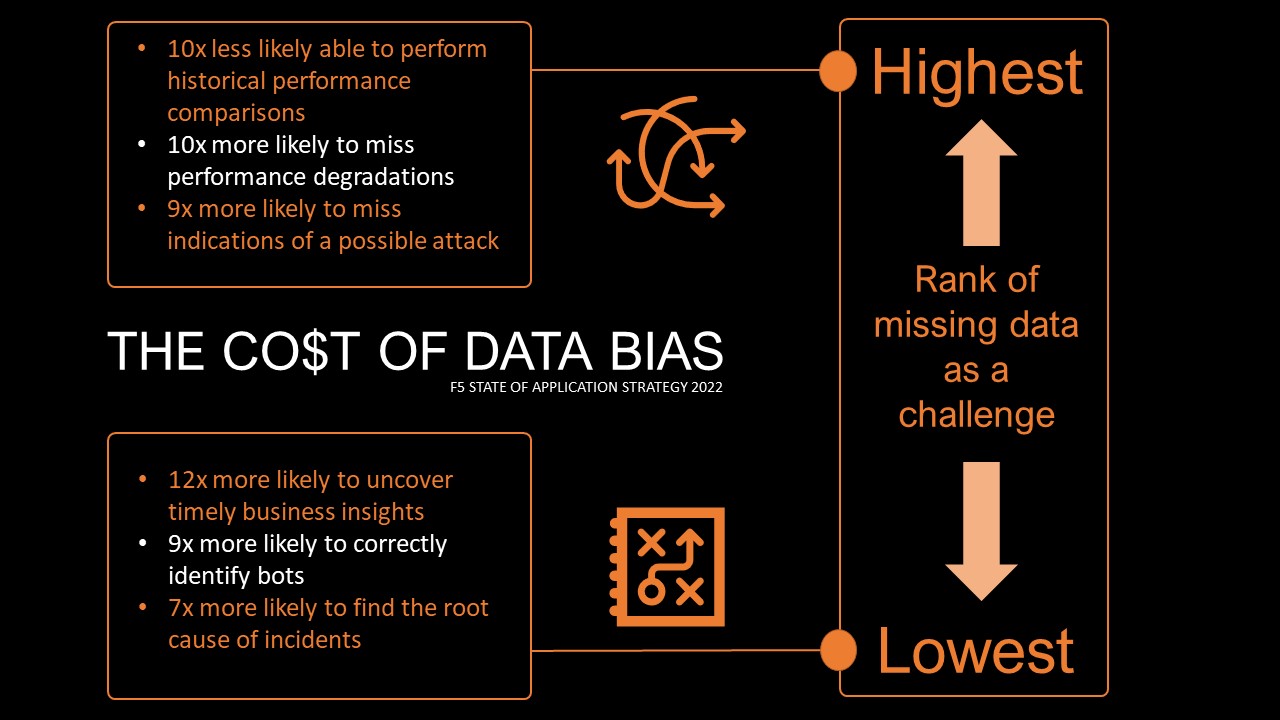O custo do viés de dados é compartilhado pela TI e pelos negócios
A coleta de dados opinativa leva à falta de dados, o que significa que você perderá insights.
Os resultados estão disponíveis. Todos os anos, pesquisamos o mercado sobre uma ampla variedade de tendências e tópicos de tecnologia e negócios. E a cada ano somos surpreendidos com algumas respostas. Uma resposta que não nos surpreendeu foi a prevalência de insights ausentes. De mais de 1400 entrevistados, quase todos – 98% – relatam que estão perdendo insights. A natureza desses insights permanece inalterada: causa raiz da degradação do desempenho, causa raiz dos incidentes e indicação de um possível ataque. Desempenho. Disponibilidade. Segurança. As “três grandes” preocupações da TI ao operar um negócio digital continuam a gerar uma necessidade de mais dados.
O impacto desses insights ausentes é preocupante. Não é mais apenas um problema para profissionais de TI responsáveis por cumprir SLAs relacionados a desempenho, disponibilidade e segurança. Interrupções, problemas e incidentes de segurança têm um impacto muito real e negativo em um negócio digital.
Alguns efeitos são óbvios. Perda de reputação e receita, diminuição da produtividade, relacionamentos prejudicados com parceiros. Outros não são tão óbvios, como a perda de oportunidades não realizadas que poderiam ter sido descobertas por meio da análise de dados em linhas operacionais e comerciais.
Mas saber que faltam insights é apenas metade da batalha. Ninguém está surpreso com isso hoje. O crescimento dos negócios digitais leva à escala e à expansão dos sistemas, serviços e ambientes necessários para dar suporte à demanda. Com tantos componentes distribuídos em várias nuvens e, agora, na borda, não é surpresa que dados ausentes tenham sido citados como o desafio mais comum enfrentado na busca para encontrar esses insights ausentes.
Este é, em parte, o custo do viés de dados: a coleta de dados opinativa.
“O custo de implantação — e gerenciamento — de agentes introduziu viés de dados porque limitou os sistemas dos quais você poderia coletar dados. Opiniões — experientes ou não — sobre a importância de monitorar um determinado aplicativo ou sistema muitas vezes impulsionaram a decisão de implantação.” – A maioria dos insights ausentes se deve ao viés de dados

Aqueles que superaram o desafio dos dados ausentes estão bem posicionados para aproveitar os insights que a análise de dados pode revelar. Essas organizações têm doze vezes mais probabilidade de descobrir insights comerciais oportunos que levam a benefícios tangíveis, como um aumento na receita por usuário.
Eles também têm mais probabilidade de identificar bots corretamente, o que significa que têm menos probabilidade de serem vítimas de bots que exploram canais digitais e podem causar estragos no próprio negócio.
O que ainda não podemos quantificar é o impacto de insights “falsos” causados pela falta de dados no negócio. Sabemos que a classificação incorreta — falsos positivos — de usuários legítimos como bots é um problema que muitas vezes leva as organizações a abrir mão da segurança ativa para evitar o possível bloqueio de um usuário gerador de receita. O Aite Group estimou que as perdas por falsos positivos excederiam em muito a perda projetada por fraude de US$ 6,4 bilhões.
E o impacto vai além da receita, atingindo outros resultados comerciais, como custo de aquisição de clientes e valor vitalício. Não é impensável que “falsos positivos” semelhantes possam surgir no futuro com relação a insights de negócios.
É por isso que é tão importante desenvolver uma estratégia de dados e observabilidade antes de começar a depender de insights para operar seu negócio digital.
Estamos à beira de um mundo digital por padrão, no qual todo negócio é um negócio digital. Os negócios digitais são baseados em dados, o que significa que desenvolver uma estratégia de dados e observabilidade é essencial para o sucesso futuro. Sem uma estratégia, os insights — e as decisões subsequentes — feitos com base nos dados podem muito bem ser os errados.
____
Interessado em aprender mais sobre as últimas ideias e inovações em segurança, desenvolvimento e infraestrutura para aplicativos adaptáveis? Inscreva-se no evento virtual Agility 2022 da F5 nos dias 15 e 16 de fevereiro.
